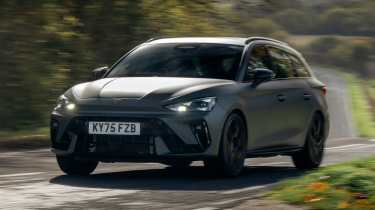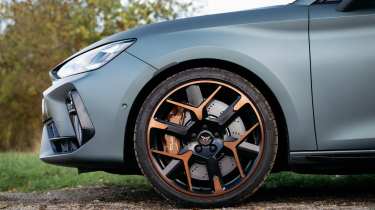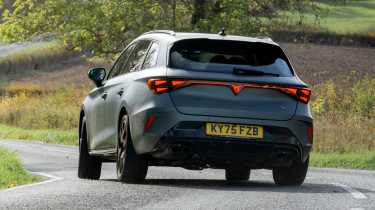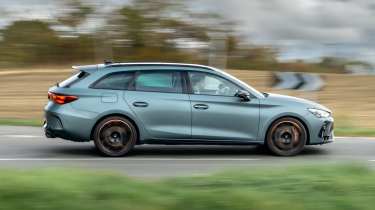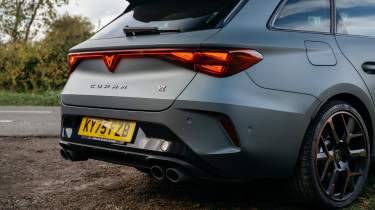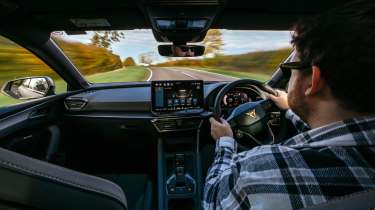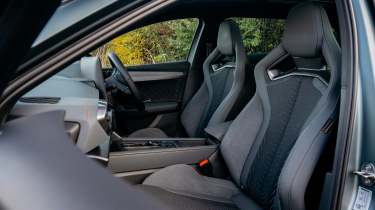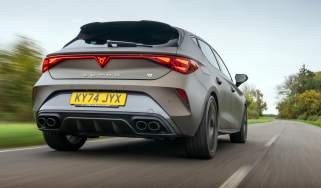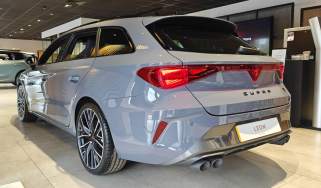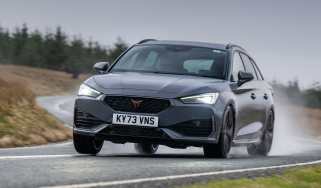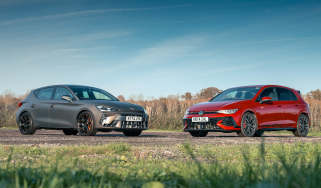Cupra Leon estate VZ3 review – more power and personality than VW's Golf R
The Cupra Leon estate is the slept-on AWD cousin to the Golf R and S3, utilising the much-lauded torque-splitter differential
Volkswagen has struggled to maintain its hold on the hot hatch market in recent years, with even the updated Mk8.5 Golf not quite bouncing back as the defaqto choice the Mk7 once was. Its Spanish relative the Cupra Leon on the other hand, revealed itself to be the driving enthusiast’s choice and that remains the case in its updated form by comparison even to the latest Golf GTI Clubsport.
The Cupra Leon estate in top-spec VZ3 trim combines the most powerful version of the EA888 turbocharged four-cylinder engine currently available with a load-lugging silhouette and four-wheel drive. As well as being the Spanish alternative to the Golf R estate, it could also be considered an alternative to Mercedes-AMG’s CLA 35 Shooting Brake. Do four driven wheels dull or enhance the driver’s appeal of the Cupra Leon?
Engine, gearbox and technical highlights
- Audi S3-spec EA888 with 328bhp
- Torque-splitter rear differential
- Optional Akebono six-piston brakes
Overall proportions have stayed the same in the update, but there’s now a new ‘shark nose’ front bumper, with a more prominent lower intake, redesigned matrix LED headlights (standard on this top VZ3 trim) and a full width rear light bar incorporating an illuminated Cupra logo.
As before, the Cupra Leon hatchback is offered only with front wheel drive, leaving space for the Volkswagen Golf R and Audi S3 in the VW hierarchy, and adopts a GTI Clubsport-spec powertrain with 296bhp from its 2-litre turbocharged four-cylinder engine. If you want more than this, at least until the new Cupra Leon VZ and VZ TCR come out, you’ll need the Cupra Leon Estate in its top VZ3 trim, which gains an additional 22bhp to deliver a 328bhp total. That peak is produced from between 5600 - 6500rpm with a 310lb ft peak torque figure at 2100 - 5500rpm. This
More reviews
It also features four-wheel drive with the much lauded torque-splitter differential as the new Golf R and Audi S3. Making use of an electronically-controlled multi-plate clutch, the system sends power to the outside rear wheel when under load in efforts to adjust attitude and create a more neutral handling balance. The diff in the rear axle also speaks to the ‘drift mode’ that can now be found in the drive profile through the infotainment system.
As in the hatch the Cupra Leon estate is suspended on 15-way adjustable DCC adaptive dampers and braking is by 357mm front discs as standard with an optional 375mm, six-piston Akebono setup available in VZ3 trim.
Performance, ride and handling
- Torque-splitter diff aids agility
- Steering slightly dull off-centre
- DCC adaptive dampers offer a good range of comfort and control
The extra punch drops 0-62mph time from 4.9sec to 4.8, a tenth ahead of the Mercedes-AMG CLA35 Shooting Brake – top speed stands at 155mph. With power sent to all four wheels through a Haldex system, traction is rarely something you have to work for in the range-topping VZ3 model, making acceleration undramatic – the lack of real exhaust sound in the cabin doesn’t help matters, with artificial sound making it impossible to hear.
It’s undoubtedly quick and can cover ground at great pace, but the engine doesn’t encourage you to reach for its redline, with short shifting and use of the low slung torque a more satisfying way to drive. It’s this that makes it excellent for long-distance motorway driving though, with surprising power available in high gears, low in the rev range.
Initial powertrain response is good with ESC turned off (thankfully a single, physical button press), with the seven-speed DSG transmission (there’s no manual option) as sharp and refined as it was before. In comfort and full automatic mode it blends into the background, but opt to change ratios yourself and it gives you exactly what you need, when you need it for the most part – we did experience the occasional slow paddle-to-shift response at full throttle, but it’s a strong transmission overall.
While the estate gets an extra 32bhp over the front-drive hatchback, a 155kg weight disadvantage puts it just 1bhp/ton away from the hatch (199bhp/ton for the estate and 198bhp/ton for the hatch).
Switch ESC to sport, energise the powertrain mid-corner and the Leon rotates keenly. The resulting sensation can take time to acclimatise to as it’s an unexpected - but welcome - level of interaction unexpected of VW Group hatches. The damping is commendable too, the 15-way adjustable adaptive dampers allowing you to find your sweet spot along a scale that ranges from harsh but controlled at its hardest, to compliant but a bit wallowy at its softest. In terms of balancing compliance and control, we found the sweet spot to be three quarters of the way along the slider, just above where it says ‘Cupra’.
This new rear axle unit does add a sense of mid-corner agility on power and mask the numb steering, which is low on off-centre response and a sense of feedback. Cupra does give you the option to adjust the steering through its numerous drive modes, but even these only seem to impact weight a quarter of a turn in, with load difficult to determine on corner entry. This is something that plagues the majority of cars on this platform though, with the Golf R and Audi S3 suffering the same.
Though all-wheel drive gives the estate a better chance of making use of its output, drive to a single axle in the hatchback makes its lower power figure feel considerably more lively. Weight distribution isn’t quite 50:50 (58:42) and on good (hot) tarmac its sticky Bridgestone Potenza Race rubber and the new rear torque vectoring unit, make the Cupra resistant to understeer. The Leon does a good job of managing its 1576kg kerb weight, the extra mass over the rear axle even serving to aid in rotating the car in quick direction changes at speed.
Driver’s note
‘Everything about the Leon just feels a bit keener, a bit more eager and more intuitive than the People’s Car equivalent. It’s more expressive and offers a clearer dialogue at speed, offering more clarity on how it wants to move around under braking or with agitated steering inputs. The four-wheel drive might make it more grown-up than the hatch but there’s still great fun to be had.’ – Ethan Jupp, evo web editor.
MPG and running costs
The Cupra Leon’s EA888 turbocharged four-cylinder engine is a known quantity, also powering everything from the Volkswagen Golf R to the Audi S3. In this Leon estate as in the Golf and the Audi, you can manage up to 40mpg on a long steady cruise, with that average figure dropping to 35mpg with mixed enthusiastic driving and even down to 30mpg if you’re giving it a proper kicking.
Unfortunately the Cupra Leon VZ3 estate does fall foul of both the expensive car supplement (for cars over £40,000), adding £425 to yearly VED bills for the car’s first five years. It also will cost over £3300 at first registration due to its 189g/km CO2 output.
Interior and tech
- Sabelt bucket seats are a must
- Good steering wheel with intuitive controls
- Infotainment still fiddly but at least responsive
Inside, you’ll find the same faux-carbonfibre steering wheel, copper detailing and lacklustre centre console as before, but Cupra has made some important changes to bring the Leon up-to-speed with its rivals.
There has been a noticeable increase in the use of more premium (and sustainable) soft touch materials, with recycled microfibre, a neoprene-esque material and a hard wearing fabric to be found on the seats and throughout the cabin. Where once there were expanses of hard plastic you’ll now find fabric cladding in most cases, lifting interior ambience and making it feel like a more premium product. While there is still some exposed hard plastic trim, overall material and build quality is strong.
Alongside the long-awaited backlit touch sliders for climate and volume control, the Leon’s infotainment system has now expanded to 12.9-inches in diameter, integrated more neatly into the dashboard and with noticeably quicker response – this new display is angled towards the driver and unlike some, doesn’t creak and bend during use. The steering wheel is also a delight, with physical, quality feeling buttons making the business of switching off the mandated nannies a doddle. Likewise there’s an actual button for turning off the stability control.
Most significant, though, is the inclusion of standard carbonfibre-backed Sabelt bucket seats with the VZ3, offering excellent support and comfort. The matte carbonfibre finish is also something you’d only usually expect to find in much more premium models, but the fact the carbonfibre mould matches the seats that made a debut in the limited-run Audi RS6 might help explain this…
Price and rivals
Though this update is mild, the changes across the board have made the Cupra Leon estate an even more compelling offering for those looking for a practical fast estate. While it still has its ergonomic flaws and lacks some of the fine driver-machine engagement we’d really like, it’s one of the best options in its segment.
The range-topping Leon Estate VZ3 costs from £50,625 in the UK at the time of writing (November 2025), over £2000 more than the previous car but actually £350 cheaper than at launch. It is nonetheless a sturdy price, at £2000 more than an entry-level Audi S3. In terms of rivals, just the Mercedes-AMG CLA35 Shooting Brake remains as its closest rival with 302bhp (plus 14bhp from an electric motor). It costs from £53,210 but with the arrival of a new-generation CLA, will surely not be around for long.
